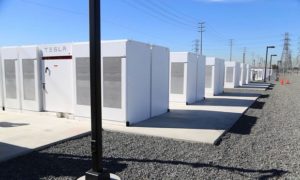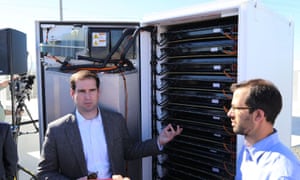Source: theguardian.com
Published: January 31, 2017

The Tesla battery farm will be used to store energy and meet spikes in demand – like on hot summer afternoons when buildings start to crank up the air conditioning. Photograph: Katie Fehrenbacher
The project is part of Elon Musk’s plan to help transform the power grid
From the road, the close to 400 white industrial boxes packed into 1.5 acres of barren land in Ontario, California, a little more than 40 miles from downtown Los Angeles, look like standard electrical equipment. They’re surrounded by a metal fence, stand on concrete pads and sit under long electrical lines.
But take a closer look and you’ll notice the bright red coloring and gray logo of electric car company Tesla on the sides. And inside the boxes are thousands of battery cells – the same ones that are used in Tesla’s electric cars – made by the company in its massive $5bn Tesla Gigafactory outside of Reno, Nevada.
This spot, located at the Mira Loma substation of Southern California Edison, hosts the biggest battery farm Tesla has built for a power company. Southern California Edison will use the battery farm, which has been operating since December and is one of the biggest in the world, to store energy and meet spikes in demand – like on hot summer afternoons when buildings start to crank up the air conditioning.
Tesla’s project has a capacity of 20 megawatts and is designed to discharge 80-megawatt hours of electricity in four-hour periods. It contains enough batteries to run about 1,000 Tesla cars, and the equivalent energy to supply power to 15,000 homes for four hours. The company declined to disclose the project’s cost.
The project marks an important point in Tesla’s strategy to expand beyond the electric car business. Developing battery packs is a core expertise for the company, which is designing packs for homes, businesses and utilities. It markets them partly as a way to store solar electricity for use after sundown, a pitch that works well for states with a booming solar energy market such as California.
Battery systems built for power companies can serve more than one purpose. A utility can avoid blackouts by charging them up when its natural gas power plants, or solar and wind farms, produce more electricity than needed, and draw from them when the power plants aren’t able to keep up with demand.
Edison and other California utilities hired Tesla and a few other battery farm builders after an important natural gas reservoir near Los Angeles, called Aliso Canyon, closed following a huge leak and massive environmental disaster in late 2015. The leak forced thousands of people in nearby neighborhoods to evacuate. It also left utilities worried about how they’d meet the peak electricity demands of coming summers if they weren’t able to dip into the natural gas storage whenever they need fuel to produce power. They couldn’t always get natural gas shipment from other suppliers quick enough to meet a sharp rise in electricity consumption.
Tesla’s CTO JB Straubel unveils the batteries. Photograph: Katie Fehrenbacher
As a result, the California Public Utilities Commission approved 100 megawatts of energy storage projects for both Southern California Edison and also San Diego Gas & Electric. The commission also asked for the projects to be built quickly, before the end of 2016.
Other energy storage projects that have been built since include a 37.5-megawatt project in San Diego County by AES Energy Storage, which used lithium-ion batteries from Samsung. AES has completed the project, which is going through the commissioning phase. AES also plans to build a 100-megawatt project for Southern California Edison in Long Beach in 2020.
Even before the Aliso Canyon disaster, the commission had already recognized the benefit of using energy storage to manage supply and demand and expected it to become an important component in the state’s plan to replace fossil fuel energy with renewables. The commission, which requires the state’s three big utilities to add more wind and solar energy to their supplies over time, also set a statement energy storage target of 1,325 megawatts by 2020.
Surrounded by rows of batteries at a ribbon-cutting ceremony at the project on Monday, Southern California Edison’s CEO Kevin Payne said the Tesla project is important because “it validates that energy storage can be part of the energy mix now” and is “a great reminder of how fast technology is changing the electric power industry”.
This latest crop of energy storage projects use a new generation of lithium-ion batteries. Historically, batteries were too expensive for energy storage, but their prices have dropped dramatically in recent years, thanks to their mass production by companies such as Panasonic, Tesla and Samsung.
Companies that buy lithium-ion batteries have been reporting drops in prices of 70% over the past two years. Tesla has said it plans to lower its battery prices by 30% by expanding production inside its Gigafactory.
At the event on Monday, Tesla’s co-founder and chief technology officer JB Straubel said: “Storage has been missing on the grid since it was invented.”
Tesla is counting on the energy storage market as an important source of revenue and built its giant factory with that in mind.
The company believes its expertise in engineering and building electric cars sets itself apart from other battery farm developers. Tesla has been developing battery packs for a decade and improved the technology that manages the batteries temperatures, which can be high enough to pose a fire risk.
Overheating is a well known problem for lithium-ion batteries, which require insulating materials and software to keep them running cool. A battery farm built next to a wind farm in Hawaii by a now-bankrupt company caught fire in 2012 and temporarily put a dampener on the energy storage market.
Tesla has been building another battery farm on the Hawaiian island of Kauai, and has projects in Connecticut, North Carolina, New Zealand and the UK.
The company is looking for opportunities to build battery farms outside of California, including the East Coast and countries such as Germany, Australia and Japan. Tesla co-founder and CEO Elon Musk has said in the past that the company’s energy storage business could one day be bigger than its car business.

